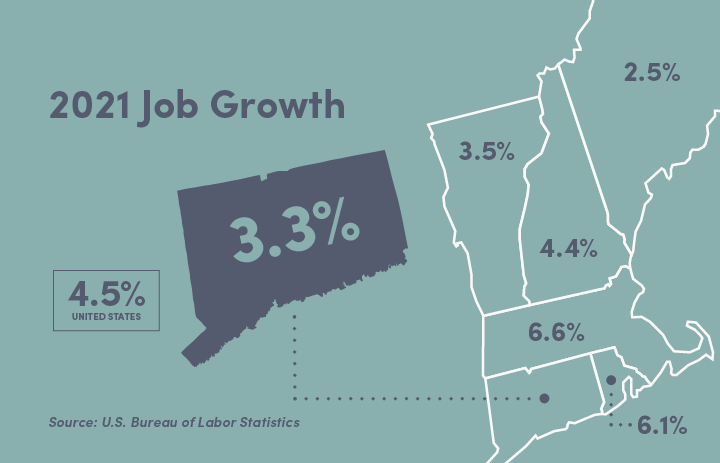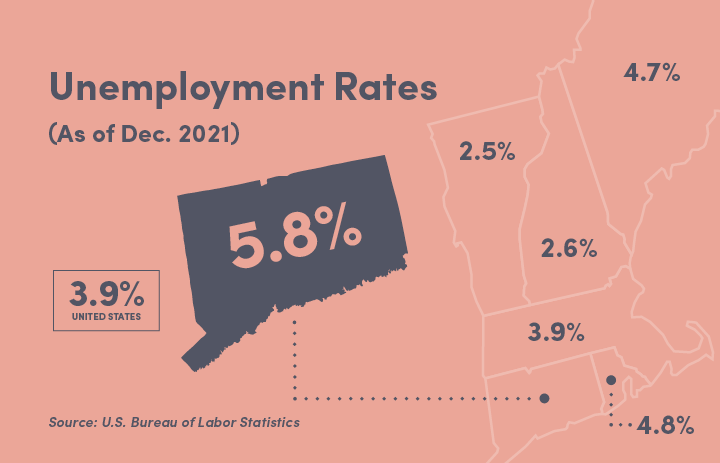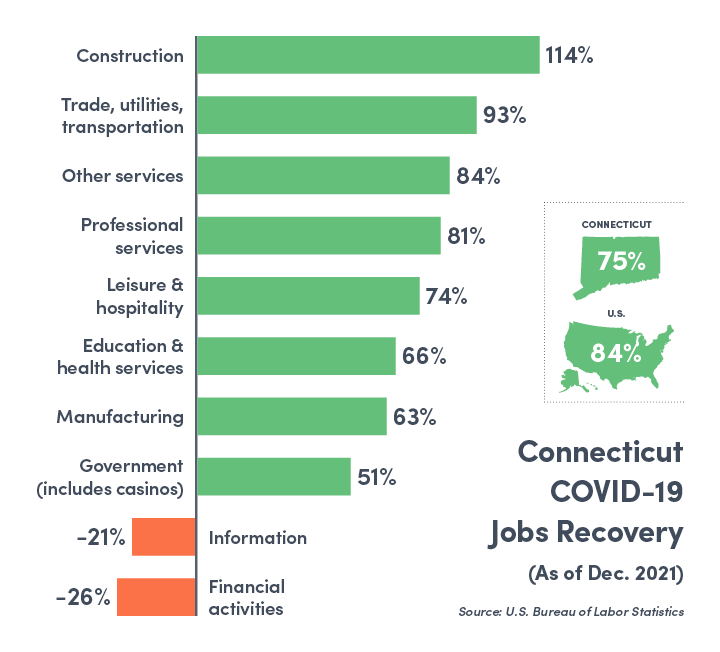Slow 2021 Job Growth Highlights Recovery Issues

Connecticut added 51,200 jobs in 2021, at 3.3% the second slowest rate of the New England states and below U.S. growth of 4.5%.
The state has recovered 75% of the historic 292,400 jobs lost in March and April of 2020 due to pandemic shutdowns and restrictions, ahead of only Vermont (73%) in the New England region.

Massachusetts and New Hampshire tied for the highest recovery rate (81%), followed by Maine (80%), and Rhode Island (77%). The national recovery rate is 84%.
“The addition of 51,200 jobs in 2021 is welcome news, although the anemic pace of our jobs recovery remains a major concern and must be addressed as a top priority,” CBIA president and CEO Chris DiPentima said.
“Massachusetts, for instance, posted 6.6% job growth last year while Rhode Island was at 6.1%.”
Connecticut’s recovery stalled at the end of the year, with just 600 jobs added in December while the Department of Labor cut November’s initially reported 5,600-job gain in half.
Labor Force Declines
The unemployment rate fell 0.2 of a percentage point last month—down 2.4 points for the year—and remains tied for sixth highest in the country and well above the U.S. rate of 3.9%.
The state’s labor force—the number of employed workers plus those actively looking for work—declined a further 17,000 people in 2021 and is down 92,000 (5%) since February 2020.
“There are 74,300 fewer people working in Connecticut today than in February 2020, despite an estimated 70,000 unfilled job openings.” DiPentima said.
“Eighty percent of employers report difficulty finding and retaining workers. The labor shortage represents the greatest threat to Connecticut’s economic recovery and long-term growth.”
DiPentima said CBIA’s 2022 policy priorities, released Jan. 21, “provide a comprehensive framework for addressing this crisis.”
“Based on last year’s growth rate, we will not recover all COVID job losses for another 18 months, and that’s not acceptable if we expect to grow the economy.
“It’s essential that policymakers avoid labor mandates and tax policies that have held back our economy for too long and do more than no harm,” he said.
“They must make job and economic growth a central focus of the 2022 legislative session so that we can realize Connecticut’s tremendous economic potential.”
Leisure and Hospitality Leads
Employment grew in eight of the state’s 10 main industry sectors in 2021, led by leisure and hospitality, which added 15,900 jobs (13.4%).
Education and health services gained 11,300 jobs last year (3.5%), followed by professional and business services (9,200; 4.5%), other services (4,400; 7.6%), construction (4,000; 7.1%), government (3,800; 1.7%), manufacturing (3,300; 2.2%), and trade, transportation, and utilities (1,800; 0.6%).
The trade, transportation, and utilities sector lost 1,000 jobs in December, more than one-third (36%) of its 2021 gains.
Professional and business services lost 700 jobs (-0.3%) last month, with information (-100; -0.4%) and leisure and hospitality (-100; -0.1%) also declining.
The key manufacturing sector led all sectors in December, adding 800 jobs to mark six consecutive months of gains.
Financial Activities, Information Decline
Financial activities lost a further 1,300 jobs in 2021 and employment in that critical sector is now 4,300 (-3.5%) below pre-pandemic levels.
Employment in the information sector declined by 1,200 (-4.1%) last year, with 3,400 fewer people (-11%) employed than in February 2020.
All six of Connecticut’s major labor markets posted gains for the year, led by New Haven with 11,200 new jobs (4%).
Bridgeport-Stamford-Norwalk added 11,100 jobs (3%) in 2021, followed by Hartford (7,900; 1.4%), Danbury (2,700; 3.8%), Norwich-New London-Westerly (2,700; 2.4%), and Waterbury (1,500; 2.3%).
RELATED
EXPLORE BY CATEGORY
Stay Connected with CBIA News Digests
The latest news and information delivered directly to your inbox.




